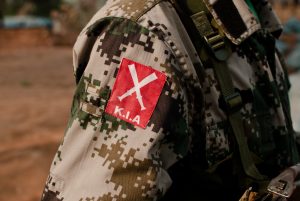Myanmar’s military junta has reportedly announced a unilateral five-month ceasefire with the country’s raft of ethnic armed organizations, as it faces intensifying and increasingly widespread resistance to its rule.
Radio Free Asia (RFA) reported yesterday that the Office of the Commander-in-Chief of the Armed Forces issued a statement late on Monday announcing that the military, or Tatmadaw, would down its weapons beginning on October 1 (this Friday) until the end of February 2022.
The statement described the cease-fire as a “gesture of goodwill” ahead of the 75th anniversary of Union Day on February 12, 2022. Union Day marks the signing of the Panglong Agreement in 1947, which is seen by many as a missed opportunity for the creation of a unified and inclusive federal state. The statement also said the ceasefire would be used to “promote the prevention and control of the coronavirus pandemic,” which has run out of control since the military seized power in February.
The ceasefire gambit comes as the military junta faces a low-level multi-focal civil war from a loose coalition of ethnic armed organizations and civilian militias that have sprung up to oppose the military’s February coup.
Last month, the shadow National Unity Government (NUG) declared a “people’s defensive war” against the junta. This “D-Day” announcement, as it was referred to in resistance circles, was followed by an intensification of attacks by rebel forces known as people’s defense forces (PDFs), named after the armed wing that the NUG established in May. PDF resistance has been particularly concentrated in Sagaing, Mandalay, and Magwe regions, and in Chin and Kayah states.
What began as hit-and-run attacks with rudimentary weapons a few months have evolved into increasingly deadly attacks on military outposts and personnel, including with automatic rifles.
At the same time, the post-coup crisis has led to inflamed conflict with the ethnic armed groups that have long struggled for autonomy or independence from the central government. According to this recent report by longtime Myanmar watcher Bertil Lintner, the Kachin Independence Army (KIA) has managed to expanded its base areas from Kachin State to parts of northern Sagaing and Mandalay regions, where it is working with local PDFs. Lintner also suggests that ethnic rebel groups including the Kachins and Karen and Karenni along the Thai border have begun supplying weapons to PDF groups.
In its decades of battles with ethnic armed groups in the rural hinterlands, Myanmar’s military benefited from the fact that the ethnic Bamar dominated central regions of the country were mostly stable, peaceful, and quiescent. Eight months on from the coup, however, it faces an increasingly robust, coordinated nationwide resistance that threatens to stretch its resources into regions that have not seen conflict for years.
For this reason, the RFA report noted, ethnic armed groups will likely see the move is a transparent attempt to take pressure off the military, allowing it to focus its efforts instead on eradicating the country’s PDF militias in the heartland of the country. If and when that task is completed, it could then turn to its “pacification” of the periphery.
RFA quoted Col. Naw Bu, a spokesperson for the KIA, who said that the military is “facing a crisis” that it hopes to solve through the ceasefire. “I think they set a time limit of five months to deal with the nationwide military operation by the PDFs,” he told the U.S.-funded broadcaster.
This would be consistent with the Tatmadaw’s past practice. Past ceasefires with ethnic armed groups have nearly always been selective and strategic. Over the years, the military has brokered ceasefires with some groups while waging battles against others, calibrating its approach to prevent the emergence of a unified front.
Given the widespread revulsion at the military since the coup, however, it might find it hard to broker similar deals with the ethnic armed groups, like the KIA, that are most opposed to its rule.

































